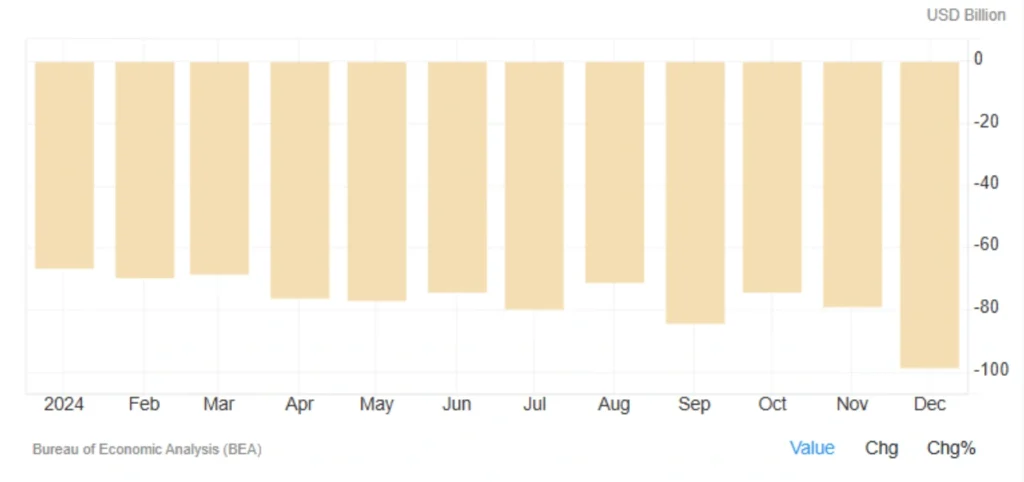
U.S. Trade Deficit Reaches $98.4 Billion in December 2024
The U.S. trade deficit reached $98.4 billion in December 2024, a significant increase from $78.9 billion in November and exceeding market expectations of $96.6 billion. This marks the highest trade deficit since March 2022, as American companies rushed to secure goods ahead of the Trump administration’s tariffs.
U.S. Trade Report for December 2024
Increase in Goods Trade Deficit: Reached $123 billion.
Decline in Services Trade Surplus: Dropped to $24.5 billion.
Imports Increased: Total imports grew by 3.5%, reaching $364.9 billion.
The largest increases were seen in processed metals, computers, and non-monetary gold.
Exports Decreased
Total exports fell by 2.6%, declining to $266.5 billion.
The biggest drops were reported in pharmaceuticals, crude oil, and computers.
U.S. Trade in 2024
17% increase in the annual trade deficit compared to 2023, reaching $918.4 billion.
Exports grew by 3.9%, totaling $3,191.6 billion.Imports rose by 6.6%, reaching $4,110 billion.
Top U.S. Trade Partners & Deficit Amounts
China: $295.4 billion deficit
European Union: $235.6 billion deficit
Mexico: $171.8 billion deficit
Vietnam: $123.5 billion deficit
Canada: $63.34 billion deficit
Read More : Blockchain in US Government: Transparency and Efficiency
Conclusion: Will Trump’s Tariffs Further Impact U.S. Trade?
1. Increased demand ahead of tariffs: Rising imports indicate that American businesses are stockpiling goods before higher trade costs take effect.
2. Declining exports due to weaker global demand: The drop in exports, especially in pharmaceuticals and crude oil, may reflect reduced foreign demand for U.S. goods.
3. Growing trade tensions: The rising deficits with China, the EU, and Mexico could lead to increased trade disputes between the U.S. and these countries.

U.S. Exports & Imports: Understanding the Trade Deficit
1. What is a Trade Deficit?
A trade deficit occurs when a country’s imports exceed its exports. This means the country buys more goods and services from abroad than it sells internationally.
2. How Does a Trade Deficit Affect the Economy?
Currency pressure: A persistent trade deficit can weaken the U.S. dollar.
Slower economic growth: Higher imports and lower exports can slow down GDP growth.
Stricter trade policies: Governments may impose tariffs or trade restrictions to reduce the deficit, but these can increase costs for businesses and consumers.
3. Is a Trade Deficit Always Bad?
Pros
Lower consumer prices: Cheaper imports help reduce costs for households and businesses.
Greater product variety: Consumers and companies get access to a wider range of goods and services.
Cons
Increased economic dependency: Heavy reliance on imports makes the economy vulnerable to global supply chain disruptions.
Declining domestic production: If local industries struggle to compete with imports, job losses in manufacturing may occur.
Final Thoughts: Will the U.S. Trade Deficit Keep Growing?
With a 17% increase in the trade deficit in 2024, policymakers may implement new trade strategies to control imports and boost exports. However, Trump’s tariffs could further reshape U.S. foreign trade dynamics in the coming months.
Share
Hot topics

Best Forex Trading Hours for Iranian Traders
The Forex market operates 24-hours a day, but clearly not every hour, equal it could even be every trading session, is profitable. There are times when the market sleeps, is...
Read more




Submit comment
Your email address will not be published. Required fields are marked *